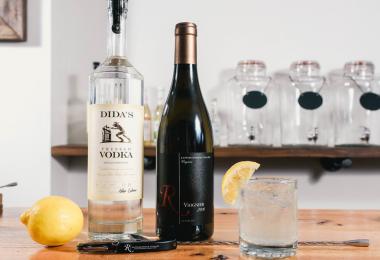Six years after Bordeaux opened its Cité du Vin beside the Garonne River in 2016 as a monument to the importance of wine tourism, Burgundy is on schedule to debut its own version by early 2022. However, Burgundy, although late to the tourism table, will be “two-upping” Bordeaux in magnitude. It is building its Cité des Vins et des Climats de Bourgogne in three venues — Beaune, Mâcon and Chablis.
“Work will begin by mid-2020 and the project team still aims at opening the Cités between the end of 2021 and mid-2022, probably with Chablis as the pilot project,” says Olivier Le Roy, appointed in July of last year by the Burgundy Wine Board (BIVB) as director of the cities project. “As with all big projects, surprises await at every street corner.”
The tourism bonanza
There are no reliable numbers about wine tourism on a worldwide basis, nor how much revenue directly contributes to individual wineries. But Bordeaux’s experience shows that investing in tourism infrastructure can have huge and steady pay-offs, with foreign visitors increasing. Sylvie Cazes, president of the foundation that runs Bordeaux’s Cité, says: “Attendance at Cité du Vin is quite regular; every year between 400,000 and 500,000 visitors. The proportion of foreign visitors has increased regularly, and we received up to 45 percent of international visitors at the end of 2019.” The number and proportion of foreign visitors is especially important as multi-day stays add extra money to travel agencies, hotels, restaurants and other cultural attractions.
In 2010, Burgundy decided to join the party, but it took years to get agreement on funding and to decide what the project would look like. In the meantime, it received a World Heritage Site designation by UNESCO in 2015 and, although such designations are increasingly common in the wine world, Burgundy embraced the recognition. Especially important in the minds of the Burgundy Wine Board was having its historic, individual vineyards recognized as “climats”, a word that suddenly appeared in all official literature. The recognition validated the decision to finally move forward with the Cité des Vins.
“The project has received a great welcome here in Bourgogne, as it reflects a whole culture rather than just the wine product,” Le Roy says. “We aim to make it strong and authentic by building a complete ecosystem around it, where people do not feel as future consumers but potential partners. These Cités must become ‘common houses’ that welcome everyone.”
Although Bordeaux and Burgundy have been historic competitors, Cazes notes: “We have been invited to share our experiences with the Burgundy winegrowers and institutions at different stages of their reflections on the project.”
Three cities
In execution, the three Burgundy sites are to be similar in intent, yet different in look and design. The Chablis city is budgeted for €2.2m ($2.37m) with 900 square metres of space, more than half of which will be devoted to exhibits and a reception area with a boutique. There will also be a dining area, tasting workshops and an exterior esplanade. It is designed to have a continual flow between areas.
“It used to be the Pontigny Abbey’s cellar,” says Cécile Mathiaud, the BIVB communication director. “Which means that for the Chablis Cité des Vins et des Climats de Bourgogne, the first stone was planted in the 12th century.” It is targeted to receive 40,000 tourists annually.
The second facility — in Macon — is planned for 1,600 square metres at a cost of €3.9m. It will merge two existing facilities, the BIVB’s Maison des Vins and the Maison Mâconnaise des Vins, located near the Saône River in downtown Macon and convenient to where river cruises dock. Its goal is to attract 55,000 visitors annually.
Not surprisingly, the Cité in Beaune will be both larger than the others and more ambitious in intent and execution. While the venues in Chablis and Mâcon are creatures of the wine bureau, the city of Beaune is also a partner in its Cité. The Beaune site will not to be a stand-alone, as are the other two, but will be the centre of a new neighbourhood, now a wooded 10-hectare lot located between the Palais des Congrès and the southernmost highway interchange on the auto route between Paris and Lyon. It will be transformed into a satellite village just outside the walled center of Beaune, with private businesses surrounding the wine building, including a large hotel, at least two restaurants, an upscale shopping mall and a concert area that will seat 1,000.
With 3,500 square metres of space, the Cité itself will be divided according to themes: land and history, wine and winegrowing and food and conviviality. It will be circular in design, an architectural version of a trellising vine, is being built at a cost of €13.5m and is expected to draw 120,000 visitors annually.
“Architecture and space are a main difference between the three, giving to each site a dedication ambience,” Le Roy says. “For example, a 12th century cellar in Chablis, riverside in Mâcon, wooded 25-acre spot in Beaune. As to the content, we expect to have more or less 70 percent identical and 30 percent specific.”
Youri Lebault, owner of Bourgogne Gold Tour in Beaune, says tour operators are not concerned that visitors to the three wine cities will abandon guided tours in the countryside. “I really think they will be even more eager to see more,” he says. “That’s why the guides and the domains should be ready to welcome even more tourists with more precise expectations than those of ordinary tourists.” Lebault also believes presence of the wine cities will encourage tourists to spend more time in the region and give more wineries a chance to share in tourist-related revenue.
New branding
The planned opening of the Cités des Vins will also coincide with a major rebranding now under way. Even though the name “Burgundy” is famous worldwide, regional leaders are campaigning for trade and consumers to switch to using the French name, Bourgogne, rather than the English translation. And they want it to be “Bourgogne wine from Bourgogne”. This preference is not a new one. The BIVB has wanted this for years, but now it is aggressively promoting it, even at the risk of confusion and certain mispronunciation by many English-speaking consumers.
While Burgundy winegrowers are focused on their three wine Cités, neighboring Lyon to the south and Dijon to the north have each launched complementary cities devoted to wine’s historic companion — food. Lyon, long considered the food capital of France, has just opened its Cité Internationale de la Gastronomie, a €230m development centred around the historic hospital, Grand Hôtel-Dieu, on the Rhone River. Dijon plans to open its own Cité Internationale de la Gastronomie et du Vin, a major, multi-building hospitality complex, in 2021.
“It will be a huge investment through which Dijon wants to reaffirm the town is the capital of the duc de Bourgogne,” Lebault says. Interestingly, both Lyon and Dijon, while promoting their own food heritage, are emphasising in their names and in their mission their intent for each complex to feature the international aspects of food.
It is an international strategy that Bordeaux has also recently adopted. In February, the Bordeaux Cité du Vin announced that it would be opening a sister facility in the Zhong Pu Hui Wine Village near Beijing, financed by the Chinese government for €60m. Scheduled to open in 2021, it will have exhibition spaces, two hotels, vacation cottages, a farm, free-trade zone and restaurants and bars.
Burgundy’s recent decision to aggressively expand its wine tourism raises the question of whether it might result in the excesses of over-tourism which has plagued other wine regions, transforming the serene beauty that drew tourists in the first place. “Above all, these Cités have to be understood as gates to the vineyards and territory,” Le Roy says. “Beaune is planning to create a privileged, zero-emission transportation means to link the Cité to the nearby city centre. Mâcon should emphasise its shuttle services. Chablis has tremendous fame, but is a small city.” There, he says, parking lots will be built on Chablis’ periphery with walking paths.
Lebault says there is still local debate on the topic, with some welcoming the tourists while others are fearful of the impact. “However,” he maintains, “it is a little bit early to say and Bourgogne, especially the Côte de Nuits and the Côte de Beaune, is not yet the Côte d’Azur.”







